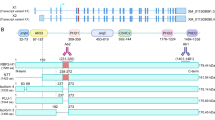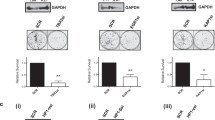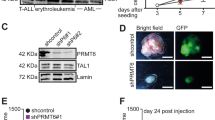Abstract
HIPK2 is a eukaryotic Serine–Threonine kinase that controls cellular proliferation and survival in response to exogenous signals. Here, we show that the human transcription factor ZBTB4 is a new target of HIPK2. The two proteins interact in vitro, colocalize and associate in vivo, and HIPK2 phosphorylates several conserved residues of ZBTB4. Overexpressing HIPK2 causes the degradation of ZBTB4, whereas overexpressing a kinase-deficient mutant of HIPK2 has no effect. The chemical activation of HIPK2 also decreases the amount of ZBTB4 in cells. Conversely, the inhibition of HIPK2 by drugs or by RNA interference causes a large increase in ZBTB4 levels. This negative regulation of ZBTB4 by HIPK2 occurs under normal conditions of cell growth. In addition, the degradation is increased by DNA damage. These findings have two consequences. First, we have recently shown that ZBTB4 inhibits the transcription of p21. Therefore, the activation of p21 by HIPK2 is two-pronged: stimulation of the activator p53, and simultaneous repression of the inhibitor ZBTB4. Second, ZBTB4 is also known to bind methylated DNA and repress methylated sequences. Consequently, our findings raise the possibility that HIPK2 might influence the epigenetic regulation of gene expression at loci that remain to be identified.
This is a preview of subscription content, access via your institution
Access options
Subscribe to this journal
Receive 50 print issues and online access
$259.00 per year
only $5.18 per issue
Buy this article
- Purchase on Springer Link
- Instant access to full article PDF
Prices may be subject to local taxes which are calculated during checkout






Similar content being viewed by others
References
Bunz F, Dutriaux A, Lengauer C, Waldman T, Zhou S, Brown JP et al. (1998). Requirement for p53 and p21 to sustain G2 arrest after DNA damage. Science 282: 1497–1501.
Calzado MA, Renner F, Roscic A, Schmitz ML . (2007). HIPK2: a Versatile Switchboard Regulating the Transcription Machinery and Cell Death. Cell Cycle 6: 139–143.
Clouaire T, Stancheva I . (2008). Methyl-CpG binding proteins: specialized transcriptional repressors or structural components of chromatin? Cell Mol Life Sci 65: 1509–1522.
D’Orazi G, Cecchinelli B, Bruno T, Manni I, Higashimoto Y, Saito S et al. (2002). Homeodomain-interacting protein kinase-2 phosphorylates p53 at Ser 46 and mediates apoptosis. Nat Cell Biol 4: 11–19.
Dauth I, Kruger J, Hofmann TG . (2007). Homeodomain-interacting protein kinase 2 is the ionizing radiation-activated p53 serine 46 kinase and is regulated by ATM. Cancer Res 67: 2274–2279.
Defossez PA, Kelly KF, Filion GJ, Perez-Torrado R, Magdinier F, Menoni H et al. (2005). The human enhancer blocker CTC-binding factor interacts with the transcription factor Kaiso. J Biol Chem 280: 43017–43023.
Deshmukh H, Yeh TH, Yu J, Sharma MK, Perry A, Leonard JR et al. (2008). High-resolution, dual-platform aCGH analysis reveals frequent HIPK2 amplification and increased expression in pilocytic astrocytomas. Oncogene 27: 4745–4751.
Di Stefano V, Rinaldo C, Sacchi A, Soddu S, D’Orazi G . (2004). Homeodomain-interacting protein kinase-2 activity and p53 phosphorylation are critical events for cisplatin-mediated apoptosis. Exp Cell Res 293: 311–320.
Di Stefano V, Soddu S, Sacchi A, D’Orazi G . (2005). HIPK2 contributes to PCAF-mediated p53 acetylation and selective transactivation of p21Waf1 after nonapoptotic DNA damage. Oncogene 24: 5431–5442.
Engelhardt OG, Boutell C, Orr A, Ullrich E, Haller O, Everett RD . (2003). The homeodomain-interacting kinase PKM (HIPK-2) modifies ND10 through both its kinase domain and a SUMO-1 interaction motif and alters the posttranslational modification of PML. Exp Cell Res 283: 36–50.
Filion GJ, Fouvry L, Defossez PA . (2006a). Using reverse electrophoretic mobility shift assay to measure and compare protein-DNA binding affinities. Anal Biochem 357: 156–158.
Filion GJ, Zhenilo S, Salozhin S, Yamada D, Prokhortchouk E, Defossez PA . (2006b). A family of human zinc finger proteins that bind methylated DNA and repress transcription. Mol Cell Biol 26: 169–181.
Gresko E, Roscic A, Ritterhoff S, Vichalkovski A, del Sal G, Schmitz ML . (2006). Autoregulatory control of the p53 response by caspase-mediated processing of HIPK2. Embo J 25: 1883–1894.
Hofmann TG, Moller A, Sirma H, Zentgraf H, Taya Y, Droge W et al. (2002). Regulation of p53 activity by its interaction with homeodomain-interacting protein kinase-2. Nat Cell Biol 4: 1–10.
Isono K, Nemoto K, Li Y, Takada Y, Suzuki R, Katsuki M et al. (2006). Overlapping roles for homeodomain-interacting protein kinases hipk1 and hipk2 in the mediation of cell growth in response to morphogenetic and genotoxic signals. Mol Cell Biol 26: 2758–2771.
James P, Halladay J, Craig EA . (1996). Genomic libraries and a host strain designed for highly efficient two-hybrid selection in yeast. Genetics 144: 1425–1436.
Kanduri C, Fitzpatrick G, Mukhopadhyay R, Kanduri M, Lobanenkov V, Higgins M et al. (2002). A differentially methylated imprinting control region within the Kcnq1 locus harbours a methylation-sensitive chromatin insulator. J Biol Chem 4: 4.
Kelly KF, Daniel JM . (2006). POZ for effect--POZ-ZF transcription factors in cancer and development. Trends Cell Biol 16: 578–587.
Lee W, Swarup S, Chen J, Ishitani T, Verheyen EM . (2009). Homeodomain-interacting protein kinases (Hipks) promote Wnt/Wg signali. Development 136: 241–251.
Li XL, Arai Y, Harada H, Shima Y, Yoshida H, Rokudai S et al. (2007). Mutations of the HIPK2 gene in acute myeloid leukemia and myelodysplastic syndrome impair AML1- and p53-mediated transcription. Oncogene 26: 7231–7239.
Moller A, Sirma H, Hofmann TG, Staege H, Gresko E, Ludi KS et al. (2003). Sp100 is important for the stimulatory effect of homeodomain-interacting protein kinase-2 on p53-dependent gene expression. Oncogene 22: 8731–8737.
Oda K, Arakawa H, Tanaka T, Matsuda K, Tanikawa C, Mori T et al. (2000). p53AIP1, a potential mediator of p53-dependent apoptosis, and its regulation by Ser-46-phosphorylated p53. Cell 102: 849–862.
Ovcharenko D, Jarvis R, Hunicke-Smith S, Kelnar K, Brown D . (2005). High-throughput RNAi screening in vitro: from cell lines to primary cells. RNA 11: 985–993.
Perez-Torrado R, Yamada D, Defossez PA . (2006). Born to bind: the BTB protein-protein interaction domain. Bioessays 28: 1194–1202.
Phan RT, Saito M, Basso K, Niu H, Dalla-Favera R . (2005). BCL6 interacts with the transcription factor Miz-1 to suppress the cyclin-dependent kinase inhibitor p21 and cell cycle arrest in germinal center B cells. Nat Immunol 6: 1054–1060.
Pierantoni GM, Fedele M, Pentimalli F, Benvenuto G, Pero R, Viglietto G et al. (2001). High mobility group I (Y) proteins bind HIPK2, a serine-threonine kinase protein which inhibits cell growth. Oncogene 20: 6132–6141.
Pierantoni GM, Rinaldo C, Mottolese M, Di Benedetto A, Esposito F, Soddu S et al. (2007). High-mobility group A1 inhibits p53 by cytoplasmic relocalization of its proapoptotic activator HIPK2. J Clin Invest 117: 693–702.
Rinaldo C, Prodosmo A, Mancini F, Iacovelli S, Sacchi A, Moretti F et al. (2007a). MDM2-regulated degradation of HIPK2 prevents p53Ser46 phosphorylation and DNA damage-induced apoptosis. Mol Cell 25: 739–750.
Rinaldo C, Prodosmo A, Siepi F, Soddu S . (2007b). HIPK2: a multitalented partner for transcription factors in DNA damage response and development. Biochem Cell Biol 85: 411–418.
Rinaldo C, Siepi F, Prodosmo A, Soddu S . (2008). HIPKs: Jack of all trades in basic nuclear activities. Biochim Biophys Acta 1783: 2124–2129.
Roscic A, Moller A, Calzado MA, Renner F, Wimmer VC, Gresko E et al. (2006). Phosphorylation-dependent control of Pc2 SUMO E3 ligase activity by its substrate protein HIPK2. Mol Cell 24: 77–89.
Rui Y, Xu Z, Lin S, Li Q, Rui H, Luo W et al. (2004). Axin stimulates p53 functions by activation of HIPK2 kinase through multimeric complex formation. Embo J 23: 4583–4594.
Tomasini R, Samir AA, Carrier A, Isnardon D, Cecchinelli B, Soddu S et al. (2003). TP53INP1 s and homeodomain-interacting protein kinase-2 (HIPK2) are partners in regulating p53 activity. J Biol Chem 278: 37722–37729.
van Roy FM, McCrea PD . (2005). A role for Kaiso-p120ctn complexes in cancer? Nat Rev Cancer 5: 956–964.
Weber A, Marquardt J, Elzi D, Forster N, Starke S, Glaum A et al. (2008). Zbtb4 represses transcription of P21CIP1 and controls the cellular response to p53 activation. EMBO J 27: 1563–1574.
Wei G, Ku S, Ma GK, Saito S, Tang AA, Zhang J et al. (2007). HIPK2 represses beta-catenin-mediated transcription, epidermal stem cell expansion, and skin tumorigenesis. Proc Natl Acad Sci USA 104: 13040–13045.
Wesierska-Gadek J, Schmitz ML, Ranftler C . (2007). Roscovitine-activated HIP2 kinase induces phosphorylation of wt p53 at Ser-46 in human MCF-7 breast cancer cells. J Cell Biochem 100: 865–874.
Zhang Q, Nottke A, Goodman RH . (2005). Homeodomain-interacting protein kinase-2 mediates CtBP phosphorylation and degradation in UV-triggered apoptosis. Proc Natl Acad Sci USA 102: 2802–2807.
Zhang Q, Wang Y . (2007). Homeodomain-interacting protein kinase-2 (HIPK2) phosphorylates HMGA1a at Ser-35, Thr-52, and Thr-77 and modulates its DNA binding affinity. J Proteome Res 6: 4711–4719.
Zhang Q, Yoshimatsu Y, Hildebrand J, Frisch SM, Goodman RH . (2003). Homeodomain interacting protein kinase 2 promotes apoptosis by downregulating the transcriptional corepressor CtBP. Cell 115: 177–186.
Acknowledgements
We thank the following colleagues for reagents: Nelson Dusetti, Roger Tsien, Phillip James, Jacques Camonis, Silvia Soddu. We are especially grateful to Gabriella d′Orazi for the HIPK2 knockdown cells, and to Patricia Le Baccon for her help. DY was supported by postdoctoral fellowships from the Curie Institute, and from Association pour la Recherche contre le Cancer. RPT was supported by a fellowship from Centre National de la Recherche Scientifique (CNRS). The Defossez lab is supported by CNRS (programme ATIP and programme PICS France-Russie), by Institut National du Cancer (ATIP Plus), by Association pour la Recherche contre le Cancer (grants no 3727 and no 4859), and by Ligue contre le Cancer. The work of MLS is supported by the Deutsche Forschungsgemeinschaft (DFG).
Author information
Authors and Affiliations
Corresponding author
Additional information
Supplementary Information accompanies the paper on the Oncogene website (http://www.nature.com/onc)
Rights and permissions
About this article
Cite this article
Yamada, D., Pérez-Torrado, R., Filion, G. et al. The human protein kinase HIPK2 phosphorylates and downregulates the methyl-binding transcription factor ZBTB4. Oncogene 28, 2535–2544 (2009). https://doi.org/10.1038/onc.2009.109
Received:
Revised:
Accepted:
Published:
Issue Date:
DOI: https://doi.org/10.1038/onc.2009.109
Keywords
This article is cited by
-
Identification of ZBTB4 as an immunological biomarker that can inhibit the proliferation and invasion of pancreatic cancer
BMC Cancer (2023)
-
miRNA-576-5p promotes endometrial cancer cell growth and metastasis by targeting ZBTB4
Clinical and Translational Oncology (2022)
-
Homeodomain-interacting protein kinase 2 regulates DNA damage response through interacting with heterochromatin protein 1γ
Oncogene (2015)
-
HIPK2 phosphorylates ΔNp63α and promotes its degradation in response to DNA damage
Oncogene (2011)



